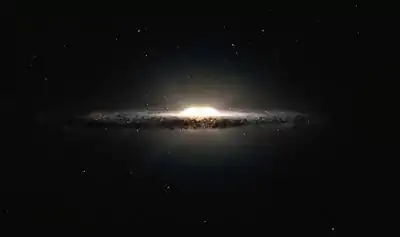Stellar archaeology
Stellar archaeology is the study of the early history of the universe, based on its early composition.[1] By examining the chemical abundances of the earliest stars in the universe: metal-poor, Population II stars; insights are gained into their earlier, metal-free, Population III progenitors. This sheds light on such processes as early star formation, nucleosynthesis in stars and supernovae, and the formation processes of the galactic halo.[2][3] The field has already discovered that the Milky Way cannibalizes surrounding dwarf galaxies, giving it a youthful appearance.[4]

Artist's conception of the Milky Way
References
- "Stellar Archaeology Traces Milky Way's History". HubbleSite. 30 May 2012. Retrieved 11 February 2014.
- Frebel, A. (2010), "Stellar archaeology: Exploring the Universe with metal-poor stars (Ludwig Biermann Award Lecture 2009)", Astronomische Nachrichten, 331 (5): 474–488, arXiv:1006.2419, Bibcode:2010AN....331..474F, doi:10.1002/asna.201011362, S2CID 119096730
- Nerlich, Steve (26 June 2010). "Astronomy Without A Telescope – Stellar Archaeology". Universe Today. Retrieved 11 February 2014.
- Brainard, Curtis (10 February 2014). "The Archaeology of the Stars". New York Times. Retrieved 11 February 2014.
This article is issued from Wikipedia. The text is licensed under Creative Commons - Attribution - Sharealike. Additional terms may apply for the media files.